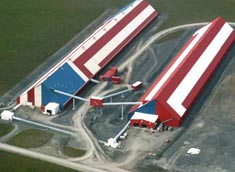Arctic Miners Vote IBEW,
One Unit at a Time
July 14, 2005
Organizing a remote Arctic zinc mine in northernmost Alaska takes more than patience and ingenuity – it requires cell phones connected by high-powered satellites. Just ask Anchorage Local 1547 organizer Chris Tuck, for whom going door-to-door to sing the union’s praises to potential members would be a highly impractical task.
 Workers at the Red Dog Mine live everywhere from Anchorage to Canada to the Pacific Northwest and other parts of the "lower 48." And access to the mine itself is restricted and isolated because of its distance from civilization. Red Dog is on the Alaska Peninsula, 90 miles north of Kotzebue, a town with a majority Eskimo population north of the Arctic Circle, which is the largest municipality around. So a key organizing standby – the house call – is not an option. Workers at the Red Dog Mine live everywhere from Anchorage to Canada to the Pacific Northwest and other parts of the "lower 48." And access to the mine itself is restricted and isolated because of its distance from civilization. Red Dog is on the Alaska Peninsula, 90 miles north of Kotzebue, a town with a majority Eskimo population north of the Arctic Circle, which is the largest municipality around. So a key organizing standby – the house call – is not an option.
Red Dog, the richest zinc mine ever discovered, opened in 1989 and expanded in 1998 and 2001. Because of the mine’s remote location, employees work one or two weeks straight, staying in on-site dormitories, then fly home. All eventually come through the Anchorage Airport.
"Contact is pretty limited," said Anchorage Local 1547 General Counsel Jake Metcalfe. "But the workers have been pretty supportive and reached out to us a lot."
 Cell phones and e-mail have proven essential communications tools for Tuck, and airport hangars are the only places for face-to-face meetings. But as untraditional as the organizing tactics are, they have been highly successful. Local 1547, which is going after the facility’s 400 hourly workers one unit at a time, has won all of the four unit elections so far this year. Local 1547 plans to keep going until the open pit mine operated by Teck Cominco and managed by native Alaska corporation Nana is wall-to-wall IBEW. Cell phones and e-mail have proven essential communications tools for Tuck, and airport hangars are the only places for face-to-face meetings. But as untraditional as the organizing tactics are, they have been highly successful. Local 1547, which is going after the facility’s 400 hourly workers one unit at a time, has won all of the four unit elections so far this year. Local 1547 plans to keep going until the open pit mine operated by Teck Cominco and managed by native Alaska corporation Nana is wall-to-wall IBEW.
"No outer reaches of the globe are too remote for the IBEW, particularly when workers need a collective voice on the job," said IBEW International President Edwin D. Hill.
The issues driving the successful domino-effect campaign are typical: management, wages and benefits. "The hands want to see the mine succeed and run smoothly, but their suggestions are not heeded by management," Tuck said. "They see it going downhill."
Wages and benefit levels make the electricians and mechanics the lowest paid in the state and the industry, Tuck said. But with intensive schedules that include 11 ½-hour days, seven days a week, most workers earn enough overtime that the low base wage is obscured.
The facility’s 18 electricians were the first to vote IBEW in February. Then came the 14 powerhouse operators in May. Next, 55 mill workers voted for the IBEW in June. An election on August 9 will decide whether the 22 warehouse workers will cast their lot with IBEW.

|

